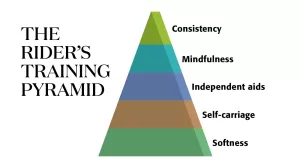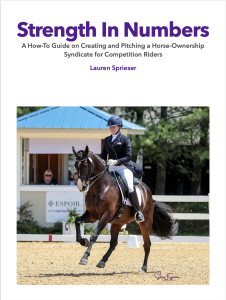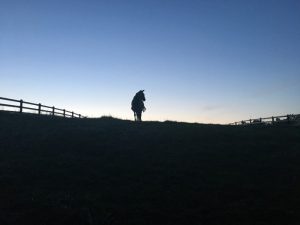The Rider’s Training Pyramid
 Sometimes my team and I are really rolling, with lots of horses and humans showing and getting somewhere and grinding it out. Other times, the youngsters are all youngstering, and I didn’t book a lot of clinics in January and February because the weather usually stinks, and we’re mostly just logging miles and waiting for something to happen. This is one of those times. But it’s meant that I’ve had time—time to go and watch the warmup at the CDIs, time to get caught up on office work, and time to do some continuing education.
Sometimes my team and I are really rolling, with lots of horses and humans showing and getting somewhere and grinding it out. Other times, the youngsters are all youngstering, and I didn’t book a lot of clinics in January and February because the weather usually stinks, and we’re mostly just logging miles and waiting for something to happen. This is one of those times. But it’s meant that I’ve had time—time to go and watch the warmup at the CDIs, time to get caught up on office work, and time to do some continuing education.
One of those opportunities was Lendon Gray’s Training4Teaching program, which offers free lectures by extremely credentialed people about teaching riders, a topic we don’t talk enough about in dressage. (We say lots about horse training, but not enough about human training.) In addition to some great pearls of wisdom from a whole panel of excellent instructors, Lendon also assigned us some homework: to develop a “Rider Training Scale” to mirror that which already exists for training the horse.
Read the rest at The Chronicle of the Horse!
 Horse ownership at any level is an expensive endeavor. There are shoes and shots and tack and hay, whether for the compassionate beginner’s teacher or the international superstar. But those international superstars have even bigger costs – FEI passports, CDI entries… the list goes on and on.
Horse ownership at any level is an expensive endeavor. There are shoes and shots and tack and hay, whether for the compassionate beginner’s teacher or the international superstar. But those international superstars have even bigger costs – FEI passports, CDI entries… the list goes on and on. Animal abuse is unacceptable, and those who commit it need to face serious consequences. Period. Hard stop.
Animal abuse is unacceptable, and those who commit it need to face serious consequences. Period. Hard stop.